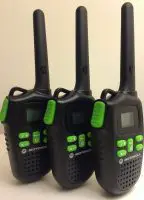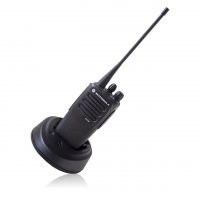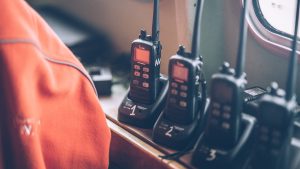
Walkie talkies can use FRS vs GMRS for their communication needs, but there are differences between the two. We compare FRS vs GMRS and help you understand the difference in set-up, frequency, and legality across the two formats.
Table of Contents
The Family Radio Service (FRS)
The Family Radio Service (FRS) is an enhanced radio system approved for use in the United States since 1996. This walkie-talkie radio system utilizes frequencies channels between 462 and 467 megahertz in the ultra high frequency (UHF) band. Baby monitors, toys, and cordless telephones operate at a frequency of 49 megahertz and citizen’s band or CB radio operates at 27 megahertz.
FRS has seen substantial adoption as a low rate, unlicensed replacement for the business band after RadioShack suggested its utilization by families. Numerous comparable personal radio services occur over the whole world.
These radio services share the same features of no or simplified end-user licenses, operation in UHF band utilizing frequency modulation (FM) and low power. However, equipment that is legal to operate in one country could cause interference that is unacceptable in another country; therefore exact frequency allocations can differ between countries.
FRS radios often provide for utilizing codes that sort out all unnecessary noise from others using the same frequency that are not citizen’s band (CB) radios. The codes that are used are sometimes designated as private line codes or privacy codes (PL).
However, contrary to what the name suggests, these codes do not supply any protection from other listeners; they are only meant to assist in sharing channels that are occupied. Tone codes cannot stop other transmissions from being overcome by stronger signals bearing a separate code.
The General Mobile Radio Service (GMRS)
The General Mobile Radio Service (GMRS) is a mobile on land FM UHF radio assistance that is created for two-way short distance communication. In the United States GMRS radios need a license, however, some GMRS devices can be utilized in Canada without a license.
GMRS radios are usually portable equipment that is handheld and operates similarly to FRS radios. They divide up the FRS frequency band near 460 megahertz.
Base and mobile station style radios are obtainable as well, however, these are usually business-related UHF radios that are frequently utilized in commercial land and public service mobile bands. It is legal to utilize these radios in service as long as they are GMRS approved. These radios are more costly than the usual walkie-talkie located in electronic stores. They are also usually thought to be of higher quality.
In the United States, adult persons and the direct family members who have a valid GMRS license are allowed to utilize the system. Employees of the person who possesses the license who are not direct family members are not included in the same license. Those that are close relatives of the person having the GMRS license are permitted to correspond amid themselves for business or personal reasons.
Any person in the United States that is 18 years of age or older and does not represent a foreign government can request a GMRS license upon completion of the application document. This can be done through the FCC’s Universal Licensing System or on paper.
Before July 1987, the FCC distributed GMRS licenses to entities that were not individuals, such as governmental bodies, partnerships, and corporations, etc. These licenses were renewed and grandfathered in. The FCC does not distribute licenses to entities that are not individuals anymore and they do not allow existing entities that are not individuals to render key alterations to the licenses.
Difference between FRS and GMRS
FRS radios are wireless, compact, handheld two-way radios that offer excellent clearness over a comparatively brief range. The radios function on any of fourteen reserved channels as selected by the Federal Communications Commission (FCC) specifically for FRS radio use.
In compliance with FCC standards, FRS radios have allowable power at a maximum of five hundred milliwatts. FRS radio antennas and transceivers cannot be altered to increase the signal range.
FRS radios are not required to utilize a license, as are other two-way radios or CB radios. There are not any per call charges, fees for airtime or usage. Except for the expense of batteries, everything is practically free to utilize.
On the other hand, GMRS radios function on eight selected channels chosen by the FCC. GMRS radios usually have an allowable power of a maximum of fifty watts and power ratings of one to five watts. For everyone that operates a GMRS radio, an FCC operator’s license is required to be purchased. FRS and GMRS can have a difference in range and channels.
GMRS radios usually reach higher ranges than FRS radios. GMRS radios can be retrofitted or outfitted with home antennas, car antennas or optional antennas to extend the range allowed by the law while FRS radios cannot be modified by law.
Other Resources
By now you understand the differences between FRS and GMRS radios, and how that impacts your walkie talkie usage. We have some other helpful guides and articles which can help you be an in-the know walkie talkie operator:





